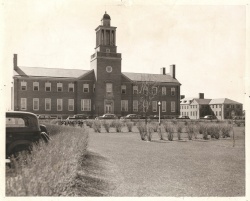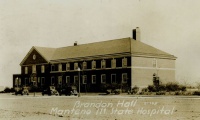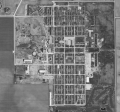Manteno State Hospital
| Manteno State Hospital | |
|---|---|
 | |
| Construction Began | 1927 |
| Opened | 1929 |
| Closed | 1985 |
| Current Status | Closed |
| Building Style | Cottage Plan |
| Architect(s) | William J.Lindstrom Charles H. Hammond |
| Location | Manteno, IL |
| Architecture Style | Georgian |
| Peak Patient Population | 8,185 in 1954 |
| Alternate Names |
|
Contents
[hide]History[edit]
The Illinois Legislature in 1927, under the administration of Len Small, voted to build a new institution for the mentally ill as Kankakee and Chicago State Hospitals were becoming overcrowded. Appropriations for the land and original buildings for a new "insane" hospital were handled by the State Department of Public Welfare. Having in mind that a large proportion of people committed to asylums came from Cook county, a location was chosen close to Chicago and yet outside of the area of high-priced land. A site was chosen near the village of Manteno. 1,000 acres were acquired in a location near the town. Plans were drawn for construction of an administration building first, followed by 100 patient cottages. The contracts were awarded December 8th, 1928.
The fact that an Illinois Central depot was located in the village of Manteno and highway 50 was completed near the site had a great deal to do with the location. In his Biennial message of 1929, Governor Len Small announced in his building report that the hospital was under construction. The cost of the administration building and 8 2-story cottages at the time was $1,172,073. The 8 two-story cottages at Manteno State Hospital were part of the original architectural plan and were the first cottages built for patients in 1928. At this time it is unclear as to when or why the architecture of the additional cottages was changed to the one-story "H" plan after 1929. Dedication ceremonies were led by the Governor on November 21st, 1929. The two-story cottages were used as alcoholic and voluntary wards in the 50s and 60s, but were closed by the 1970s. There are many contributing factors as to why these buildings were eventually closed. It may have been too easy for suicidal patients to leap from the top of the inner staircases, access may have been too difficult for the elderly or infirm or that interior access to their basements (eventually leading to the tunnel system) proved to be too dangerous.
On the morning of December 27th, 1930, a train arrived in Manteno carrying 100 male patients from Kankakee and Chicago State Hospitals. Fifteen staff members from the hospital were there to greet them. Dr. Ralph Hinton was the first administrator and many people who lived in Manteno rushed to apply to work at the newly built institution. Manteno State Hospital gave jobs to many people during the Great Depression.
By 1939 Manteno State Hospital had grown to twice the size of Kankakee State Hospital. There were 5,385 patients on the census for that year. In the late spring a typhoid epidemic swept through the hospital causing 60 deaths and over 400 seriously ill. Despite the news of the epidemic, the patient population continued to grow. Dr. Hinton introduced a concept, also used by Kankakee State Hospital; where patients were used to work the hospital farmland. Working the farm as part of their on-going therapy was crucial to their rehabilitation. The idea was used throughout the US at other hospitals with success.
By 1940 the hospital was one of the largest of its kind in the country. Also in that year, Dr. Walter Baer was named the new superintendent and continued to oversee the growth in the number of patients and crops from farming. He also introduced recreation and entertainment (the recreation building was later named for him, Hinton Hall). This included concerts and dances composed of patients, staff and members of the community.
The years during WW2 were very difficult for staffing and the budget. The ratio of staff to patient plummeted and were the worst in the hospital's history. By 1949 the patient population skyrocketed to 6,926; while the institution was built to accommodate a maximum of 5,000. Treatments continued to be occupational and activity oriented. Intensive treatment was carried out on about 2,000 patients a year, this included shock therapy and lobotomies. The farm cultivated over 900 acres through the late '40s.
In the 1950s Manteno State Hospital was at it's height. The patient population reached 8,185 in 1954, the 4th largest in the nation. Most new patient admissions were now brought in by a state run bus instead of railroad. It made the trip from Cook County Psychopathic hospital to Elgin, Kankakee and Manteno. It was painted Robins Egg blue, earning it the nickname "Bluebird".
New admissions went directly to the Diagnostic building, aka the Singer building. Here they would go through a process of showering, new clothes treatment for vermin if needed. They would then spend days or sometimes weeks there for a psychological assessment before being transferred via underground tunnels, to either one of the cottages or the farm colony for those with less needs or concerns.
Over the next 3 decades the hospital changed greatly. Patient population declined rapidly and new therapies were introduced. Most of the 1960s Manteno State Hospital found itself in many scandals and investigations. Some found to be true, others false. In 1983 it was suggested that the hospital be closed due to budgetary reasons and in 1985 it closed it's doors for good. The north half of the campus was turned over to the Veterans Administration (VA) for housing elderly veterans, and remains in use by them today. The southern half now has a mix of light industrial, single family homes, and a group recovery home for troubled youth. The redevelopment has being bought by private groups, most by the Diversatech group. Diversatech group demolishing many of the 1 & 2-story cottages due to public safety concerns and disrepair.
Additional Info[edit]
- In 1953, William C. Dement, M.D., Ph.D made discoveries during sleep studies at MSH about REM (Rapid Eye Movement: active period during which dreaming occurs) in schizophrenic patients.
- From the mid to late 1950s, Dr. Carl C. Pfeiffer and Dr. Nathaniel S. Apter were research consultants at Manteno State Hospital. Their research work involved schizophrenia and epilepsy, tranquilizing drugs, pharmacological studies, bilaterally adrenal-ectomized chronic schizophrenic patients, anti-schizophrenic acting drugs, social science and chronic involutional psychotic studies.
- Another unique feature of the Manteno State Hospital was the size and capabilities of its on-site laundry facility. The hospital's laundry processed about 117 tons per week in warm months. During cold months output dropped to 114 tons. MSH laundry, which started operating in October of 1966, is believed to be the world's largest and could process 10,000 pounds per hour. No other laundry can process over 7,000 pounds hourly, State laundry officials say.
Manteno State Hospital News, October 1966
People[edit]
Information taken from National Register of Historic Places paperwork
- GUSTAF OSCAR DALSTROM (1893-1971)
In 1936, through the Federal Art Project, Manteno State Hospital secured a number of murals for the lobby of the Administration Building. These murals have a historic setting and are based on a poem by Oliver W. Barnard who was at one time the owner of the land, which now comprises the campus of the institution. The murals were the work of former Chicago Art Institute student, Gustaf Oscar Dalstrom, who later became President of the Chicago Society of Artists and whose paintings, in 1939, were loaned to the White House at the request of President and Mrs. Roosevelt.
- WILLIAM C. DEMENT, M.D., Ph.D. (1928-)
"William C. Dement, M.D., Ph.D, is the world's leading authority on sleep, sleep deprivation, and the diagnosis and treatment of sleep disorders." Conducted sleep research studies at Manteno State Hospital in 1953 and discovered that chronic schizophrenics experience REM equally as often as mentally healthy individuals. Dement is currently Director of the Stanford University Sleep Disorders Center and author of "Some Must Watch While Others Sleep", "The Sleepwatchers", and "The Promise of Sleep: A Pioneer in Sleep Medicine Explores the Vital Connection Between Health, Happiness and a Good Night's Sleep".
- CARL CURT PFEIFFER, M.D., PhD., Rev. (1908-1988)
The pioneer of biochemical therapy, Dr. Carl C. Pfeiffer was a research consultant at Manteno State Hospital in the 1950s. Dr. Pfeiffer wrote many books and papers about nutrition and its relation with mental health. His most notable book, Nutrition and Mental Illness: An Orthomolecular Approach to Balancing Body Chemistry, written in 1987 is still very popular today.In 1973, he opened the Brain Bio Center in Princeton, New Jersey where during his research he found that many psychological problems could be traced to biochemical imbalances in the body. The Center developed series of tests to determine the various biochemical imbalances, which could then be treated with orthomolecular therapy.
- WILLIAM BEECHER SCOVILLE (1906-1984)
According to, " Loss of Recent Memory After Bilateral Hippocampal Lesions" by William Beecher Scoville & Brenda Milner, William Beecher Scoville was actually at MSH on May 13, 1954, where he assisted in a "bilateral medial temporal lobe resection combined with orbital undercutting" on patient "D.C."(Similar to the famous case of "H.M.") Dr. W .B. Scoville was a neurosurgeon who developed the aneurysm clip (Scoville clip) that bears his name, and the author of over 100 scientific articles, including topics such as psychiatric surgery.
- ALFRED PAUL BAY, M.D. (1910-2000)
Psychiatrist and Superintendent at Manteno State Hospital 1947 -1953 Bay was coauthor of Therapy By Design: Implications of Architecture for Human Behavior by Good, Siegal and Bay, 1965. This book describes one of the first research projects to study the effect of architectural environment on human behavior.
- MARY L. SILVIS (1871-1943)
Assistant Director of the Department of Public Welfare 1929-1933 and 1941-1943. She was the first woman in Illinois to hold this position and a cottage at Manteno State Hospital was named after her.
- RICHARD S. DEWEY (1845-1933)
American psychiatrist; assistant physician at Elgin State Hospital 1871-1879 Superintendent of Kankakee State Hospital (1879-1893) where he adapted the cottage plan as the basic architecture for Manteno State Hospital. Dewey was the author of, Recollections of Richard Dewey, Pioneer in American Psychiatry; An Unfinished Autobiography, published in 1936.
- RODNEY H. BRANDON (1881-1968)
Director of Illinois Department of Public Welfare 1929-1933 and 1941-1942 Manteno State Hospitals Brandon Buildings were named after him.
- ARCHIE LEONARD BOWEN (1869-1945)
Director of the Illinois Department of Public Welfare 1933-1941 Manteno State Hospitals Bowen Building was named after him."As director of Public Welfare he exercised an executive and administrative supervision over 25 public, charitable and penal institutions in the State of Illinois containing 56,000 patients, inmates and prisoners. These were scattered over the State of Illinois from Chicago to Anna and included institutions at Alton, Jacksonville, Kankakee, Dwight, Manteno, Menard, Peoria and Joliet... In southern Illinois there were held five clinics for tracoma, In the Institute for Juvenile Research in Chicago there was held the largest research clinic in the world... In addition to this service as Director of Public Welfare he was in charge of investigations of and allowance of old age assistance for which at the commencement of the service there were 123,000 applications and now are approximately 225,000.... In addition to this service he is supervisor of the Federal Social Security Service for handicapped children involving about 20,000 crippled children and in addition to this about 2,000 or 5,000 dependant children placed in homes came under his supervisory jurisdiction. Excerpt from A Report On A Typhoid Fever Epidemic At Manteno State Hospital In 1939, Printed in 1945 by Authority of the State of Illinois
- HAROLD C. PIEPENBRINK (1926-1976)
Manteno State Hospital Superintendent from March 1, 1967 to August 31, 1970 Later Mr. Piepenbrink became president of the Association of Behavioral Healthcare Management (ABHM). (The Harold C. Piepenbrink Award for outstanding service in the field of Mental Health Administration named after him.)
- ELLA CURRY, R.N.
Manteno State Hospital Superintendent from March 1, 1975 to March 15, 1978 by the director of mental health and developmental disabilities. She has been director of sub region 12 of the department at the Tinley Park Mental Health Center. She is the first Black woman to head a major mental health facility in the United States.
- WILLARD VAN DYKE (1906-1986)
Willard Van Dyke was a photographer, cameraman, director, producer, and scriptwriter whose name became synonymous with social documentary in the U.S. from 1935 to 1968. Van Dyke directed, "Working and Playing to Health", which was filmed at the Manteno State Hospital in 1953. This historical documentary presents an absorbing record of the occupational, recreational, and industrial therapy programs offered by the Manteno State Hospital at the time. Filmed under sponsorship of the Illinois Department of Public Welfare, this film was featured in the 1955 issue of JHPER: National Recreational Therapy Section News. Van Dyke was also coauthor of "An Introduction to the American Underground Film", by Sheldon Renan and Willard Van Dyke, 1967.
Images of Manteno State Hospital[edit]
Main Image Gallery: Manteno State Hospital
Video[edit]
1953 film about therapy programs
This is a video slide show and history of the hospital:
Cemetery[edit]
Now known as the State of Illinois Veterans Home Cemetery, it originally opened as the Manteno State Hospital Cemetery & was used up until the early 1970s for patients. It contains about 4,000 sets of remains. The cemetery is divided by religion, mostly Catholic or Protestant. It is still used by the VA for burial of veterans.





